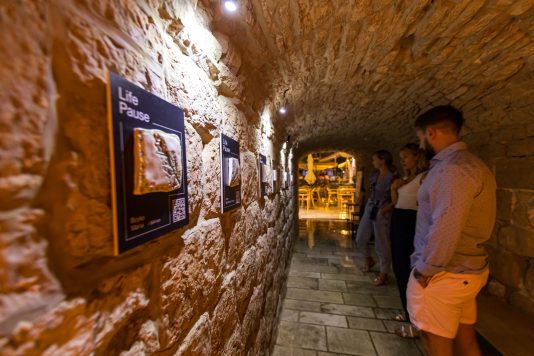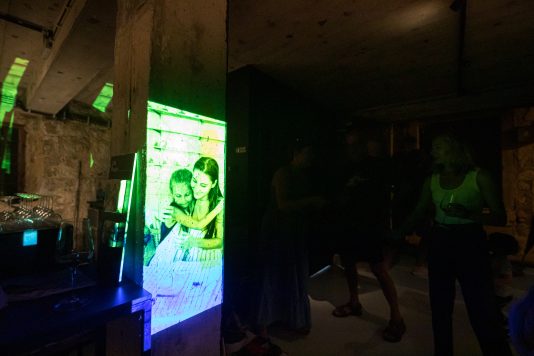MORRA CERAMICS
Context
The global context of this year’s programme is shaped by the need to react to the war in Ukraine and the ongoing concern about the global environmental crisis. Locally, our focus was on the creation of the new space of artistic production in which Lab852 was involved – Monade Gallery in Jelsa, Island Hvar, as a home of the main cultural event that we produce – Jelsa Art Biennial.
The space is in the historical centre of the town and as such it is a protected cultural asset. In terms of use, the space historically functioned as a food storage, and later as wine making and storage space. Due to its primary function (cooling, drying), the space is buried practically below the sea level and located in the “Kala” – a street in the grid of a Mediterranean city and according to more consistent urban plans, placed favourably in relation to the direction of the winds. Entrance from the street added a public and social function to it in the season of grape harvest and wine production when interactions were spontaneously happening in an open-door manner.
More recently, because of the fragmentation of the family property and changes in its functions brought by the mass tourism, the space functioned as a storage space for the surrounding businesses. Air conditioners, ventilation and garbage depot began to dominate the view of the kala and with the seasonal suspension of traffic on the waterfront (the parallel main street), all motor traffic of the place spontaneously moved to the kala, despite the bans. It negatively affected the safety of pedestrian traffic and the quality of life of residents. These circumstances resulted in conflicts between different users, which was important to take into account when designing a new use for the space and planning the program.
Taking into consideration the needs of different users of the inner private space (local environmental association, contemporary art production company and commercial business) as well as the outer public space (pedestrians, residents), architect Zdravko Krasić designed a space that has the possibility of functioning as a gallery, bar, shop, space for workshops and lectures. With the design of urban furniture that enables the simultaneous retention and passage of pedestrians, a balance was created between the private and the public use of this extremely limited space, which at the same time completely cancelled motor traffic through the street.
Architect Josipa Slaviček approached the space theoretically and, as part of this year’s activities and did preliminary research on the context of program development. Sustainability and circularity reflected in the ability of the space to programmatically adapt to seasonal changes and different types of users was also a conceptual basis of the exhibition program, used by artists in residence for their work on site specific projects. From this point of departure and taking into account the context of the space, its historical tasks, current state and vitality, the exhibition program leaves the very framework of the gallery and spreads along the street to the benefit of all residents and passers-by.
Program Postcards
Within previously mentioned context, program Postcards was developed to encourage research and evaluation of the lesser-known elements of the local heritage of Jelsa and the island of Hvar and their (re)interpretation outside of the usual tourist-commercial narrative. Using the very idea of a postcard as a format for presenting a place to “others”, the aim was to strengthen the sense of the local identity based on the richness of one’s own cultural and natural heritage, traditions, relationships, and community practices that contribute to their preservation and development. The program started with an Open Call for artists in June and consisted of four exhibitions that were results of four residencies during July, August and September. Including local community in every designed activity, and running parallel to the main part, the program was accompanied with two thematic walks with expert collaborator, an interactive shadow hunt on the island and Kids2kids workshop. The entire program took place in the year prior to Jelsa Art Biennial. As such, it was part of the process to develop a concept for Jelsa Art Biennial 2023.
Postcards 04_Life Pause
One of the main concerns approached through different artistic expressions for the last half of the year is the war in Ukraine. From the very first moment, the necessity of a reaction became evident. Maybe it was a memory of a recent war in Croatia, maybe it was an ingrained need or both, but as soon as we learned about the Ukrainian duo in Zagreb, the communication started. Morra Ceramics is a Ukrainian feminist ceramics project founded by Anastasia Vishynakova and Yana Guselnikova. In their work, the artists combine ceramics with social activism and share stories and messages to the world by producing ceramic objects, while also organizing ceramic workshops quite often. After they have fled Kharkiv in the face of the Russian invasion, Nastya and Yana found a new temporary home in Zagreb, where, with their extraordinary willpower and the support of donors, they restarted their ceramic and community workshop.
“Life pause” by the Ukrainian artistic duo Morra Ceramics is a project that gathers and presents the stories and experiences of Ukrainian citizens who fled the war and temporarily settled in Croatia. Their stories became tangible on ceramic objects created collaboratively between the artists and the participants. “Taking a temporary moment of rest, a short break after exertion” is the definition of the word pause which sounds tempting to the ears of overworked folks, when it is implemented positively in different dimensions of living. Still, there are different types of pauses, those that are not wanted, in which human lives are put on hold.
At the workshops held in Zagreb, Jelsa and Split, the artists collaborated with individuals from the Ukrainian communities, bringing them together to make clay plates with impressions of various plants, during which, while sharing experiences, they collected stories about leaving Ukraine in the middle of the invasion, about the first moments of the war in their homes, schools, about the sudden and disruptive transitions brought to their lives and the lives of their loved ones. In the process of making clay objects, numerous dimensions and metaphorical meanings of selected plants were considered, as carriers of memories and emotional impressions in the form of prints in wet clay.
In this sense, “Life pause” considers the bonds between the people and the hidden meanings and dimensions of the elements of nature, with the aim of creating a safe environment for sharing, but also encouraging the integration of individuals into the social life and culture of the places where the workshops took place. The exhibition itself, set up in the public space of Jelsa, shows the results of the process of making ceramic fragments and sharing experiences, it testifies to the courage of individuals in revealing their personal stories, but also to the unnecessary destruction that war leaves on the lives and psyche of every single person it touches.
Music theory claims that music exists between the notes, not in the notes themselves, that a pause is not a moment of nothing, but a time to experience and process what has been heard. Perhaps in the processes where communities are created for conversation, laughter, putting hands in clay and empathy we can find other dimensions of the pause, a pause where people can connect and create something as beautiful as a ceramic object, as beautiful as a growing plant by the sea, as wonderous as an understanding.
Text written by Jelena Mićić




























